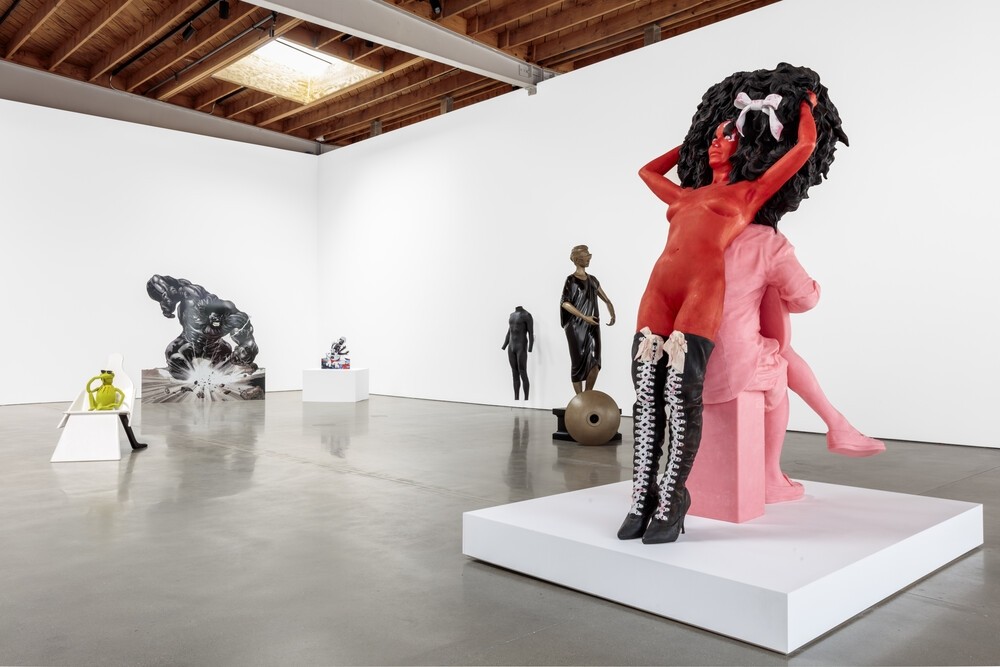
Post Human
“Post Human was virtually a manifesto trumpeting a new art for a new breed of human,” wrote the art historian and curator Robert Rosenblum discussing the impact of the exhibition in the October 2004 issue of Artforum.
In 1992, Post Human, curated by Jeffrey Deitch, brought together the work of thirty-six young artists interested in technological advancement, social and aesthetic pluralism, and new frontiers of body and identity transformation. Through their art, these artists were exploring the same questioning of traditional notions of gender, sexuality and self-identity that was—and still is—taking place in the world at large. Capturing a developing social and scientific phenomenon, Post Human theorized a new approach to the construction of the self and interpretation of what defines being human. The exhibition set the agenda for the 1990s, and its influence on artists and philosophers led to a new field of academic study.
In her book Posthuman Feminism (2022), the philosopher and feminist theoretician Rosi Braidotti credits Deitch for capturing “the avant-garde spirit of the age by foregrounding the role of technology in blurring binary boundaries between subjects and objects, humans and non-humans.” She adds, “Post Human showed also that art assumed a much more central role as it merged with science, computerization and biotechnology in further re-shaping the human form and perfecting a flair for the artificial.”
The catalogue of the 1992 exhibition, with its visual essay and innovative design by the late Dan Friedman, also proved lasting relevance. Deitch’s influential essay predicted many of the scientific and sociological shifts that have since shaped our cultural and social environment, even the pandemic.
More than thirty years later, Post Human at Jeffrey Deitch, Los Angeles, revisits the theme of the exhibition, bringing the discourse into the present. The show includes several of the key figures who participated in the 1992 exhibition in dialogue with some of the most interesting artists continuing the exploration of these themes today. In keeping with the social and technological trends that inspired it, the interest in figuration of the original artists and the younger generations presented in the show is conceptual rather than formal.
Much of the then-new figurative work was descriptive of the “real” world but cannot, in fact, be called “realistic” in the conventional sense. That is because so much of the “real” world the artists were reacting to had become artificial. With the concept of the real disintegrating through an acceptance of the multiplicity of reality models and the embrace of artificiality, Realism as it was once known was no longer possible. This new figurative art may have actually marked the end of Realism rather than its revival.
Fully integrated into our pop psychology, the term “posthuman” is now used in everyday conversations and has come to primarily identify with the trope of the cyborg. This exhibition, like the 1992 show, however, examines multiple declinations and aspects of the postmodern construction of personality and the engineering and transcendence of the human body. The artists in the exhibition embrace notions of plurality, metamorphosis and multi-beingness. Cyber-futuristic, surgically improved, commodified, stereotyped, and politicized, the “cultured body” lends itself to reflect on a variety of concerns that define our age.
Several works in the exhibition will embrace the biometrical aestheticization of the human body to address the decay paranoia, the social conflict over genetic engineering and the use of biotechnologies, and the conversation around the limits of “natural” life.” Artists have long engaged with the threats of biometric surveillance, the possibility of virtual reality overtaking our physical one, the accelerating real-time consumption of experience, and the automation of the workforce. As AI’s ability to fulfill our creative and specialized needs has reached mass fruition, artists are confronting the impact of what was once considered speculative science fiction, an everyday reality.
Post Human was first presented at FAE, Musée D’art Contemporain, Pully/Lausanne (June 14–September 13, 1992) and traveled to Castello di Rivoli—Museo d’Arte Contemporanea, Rivoli/Turin (October 1–November 22, 1992), Deste Foundation, House of Cyprus, Athens (December 3, 1992–February 14, 1993), Deichtorhallen Hamburg (March 12–May 9, 1993), Israel Museum, Jerusalem (June 23–October 10, 1993). A number of the works shown in 1992-1993 are now in international museum collections. Matthew Barney’s REPRESSIA (decline) (1991) is now in the collection of LACMA, where it was on view in 2023. Posthumanism has since been the subject of countless books, movies and high-profile exhibitions.
Post Human will be presented as part of the Participating Gallery Program for Getty’s PST Art: Art & Science Collide, joining in a dynamic exploration of the intersection of art and science this fall. The exhibition is curated by Jeffrey Deitch with Viola Angiolini, Senior Director, Research and Curatorial Projects.
The artists participating in Post Human are:
Isabelle Albuquerque
Matthew Barney
Ivana Bašić
Frank Benson
Ashley Bickerton
Maurizio Cattelan
Chris Cunningham
John Currin
Alex Da Corte
Olivia Erlanger
Jana Euler
Rachel Feinstein
Urs Fischer
Pippa Garner
Robert Gober
Hugh Hayden
Damien Hirst
Tishan Hsu
Pierre Huyghe
Anne Imhof
Alex Israel
Arthur Jafa
Jamian Juliano-Villani
Mike Kelley
Josh Kline
Jeff Koons
Paul McCarthy
Sam McKinniss
Mariko Mori
Takashi Murakami
Wangechi Mutu
Cady Noland
Charles Ray
Cindy Sherman
Kiki Smith
Hajime Sorayama
Anna Uddenberg
Cajsa von Zeipel
Jeff Wall
Jordan Wolfson
Anicka Yi